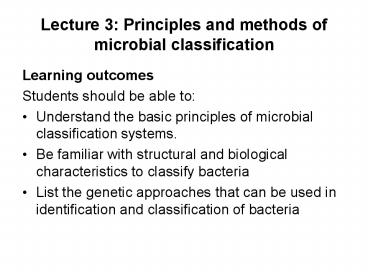Lecture 3: Principles and methods of microbial classification PowerPoint PPT Presentation
1 / 20
Title: Lecture 3: Principles and methods of microbial classification
1
Lecture 3 Principles and methods of microbial
classification
- Learning outcomes
- Students should be able to
- Understand the basic principles of microbial
classification systems. - Be familiar with structural and biological
characteristics to classify bacteria - List the genetic approaches that can be used in
identification and classification of bacteria
2
Microbial Identification
- Basic Concepts of Identification
- Isolation and Identification of Specimens
- Reading material
- Jawetz, Melnick Adelbergs, Medical
Microbiology, Chapter 3. - Prescott, Harley, Klein. Microbiology. Chapter
2.
3
Basic Principles
- Classification Systems
- Levels of Classification
- Definition of Species
- Nomenclature
- Useful Properties in Microbial Classification
- Microbial Phylogeny
4
Classification Systems
- Taxonomy
- Classification of living organisms into groups
- Phylogenetic Classification System
- Groups reflect genetic similarity and
evolutionary relatedness - Phenetic Classification System
- Groups do not necessarily reflect genetic
similarity or evolutionary relatedness. Instead,
groups are based on convenient, observable
characteristics.
5
Phylogenetic tree classification by molecular
and cellular relationships
6
Levels of Classification
- Taxon
- A group or level of classification
- Hierarchical broad divisions are divided up into
smaller divisions - Kingdom (Not used by most bacteriologists)
- Phylum (Called Division by botanists)
- Class
- Order
- Family
- Genus (plural Genera)
- Species (Both singular plural)
7
Definition of Species
- The basic unit of taxonomy, representing a
specific, recognized type of organism - For sexually reproducing organisms, a fundamental
definition of species has been reproductive
compatibility - This definition fails for many microbial species
(including bacteria), because they do not
reproduce sexually
8
Definition of Species
- Defintion of species in microbiology
- Classic definition A collection of microbial
strains that share many properties and differ
significantly from other groups of strains - Species are identified by comparison with known
type strains well-characterized pure cultures
references for the identification of unknowns - There are several collections of type strains,
including the American Type Culture Collection
(ATCC)
9
Definition of Species
- Defintion of species in microbiology (cont.)
- Strain
- A population of microbes descended from a single
individual or pure culture - Different strains represent genetic variability
within a species - Biovars Strains that differ in biochemical or
physiological differences - Morphovars Strains that vary in morphology
- Serovars Stains that vary in their antigenic
properties
10
Nomenclature
- Scientific name (Systematic Name) Binomial
System of Nomenclature - Genus name species name
- Italicized or underlined
- Genus name is capitalized and may be abbreviated
- Species name is never abbreviated
- A genus name may be used alone to indicate a
genus group a species name is never used alone - eg Bacillus subtilis B. subtilis
11
Nomenclature
- Common or descriptive names (trivial names)
- Names for organisms that may be in common usage,
but are not taxonomic names - eg tubercle bacillus (Mycobacterium
tuberculosis) - meningococcus (Neiserria meningitidis)
- Group A streptococcus (Streptococcus pyogenes)
12
Useful Properties in Classification
- Colony morphology
- Cell shape arrangement
- Cell wall structure (Gram staining)
- Special cellular structures
- Biochemical characteristics
13
Useful Properties in Classification
- Serological Tests
- Use group specific antiserum isolated from the
plasma of animals that have been sensitized to
the organism - The antiserum contains antibody proteins that
react with antigens on the unknown organism. - The reaction can be detected by examining
agluttination or by using sera labeled with
colorimetric or fluorescent labels
14
Useful Properties in Classification
- Serological Tests (cont.)
- Advantages
- Highly specific
- Does not usually require the organism to be
isolated into pure culture - Can be used to identify organisms that cant be
grown on medium
15
Useful Properties in Classification
- G C content
- Estimated by determining the melting temperature
of the DNA - Higher G C gives a higher melting temperature
16
Useful Properties in Classification
- Nucleic acid hybridization
- By mixing ssDNA from two different species and
determining the percentage of the DNA that can
form dsDNA hybrids - The greater the percent hybridization, the closer
the species
17
Useful Properties in Classification
- Nucleic acid sequencing
- Genes for specific enzymes
- The nucleic acid sequence for the complete genome
of several species is now available - 5S and 16S rRNA (ribosomal RNA) sequences
comparison of these sequences has been
extensively used to determine the phylogenetic
relationships of microbial groups
18
Microbial Phylogeny
- Bergeys Manual of Systematic Bacteriology
- In 1927, David Bergey colleagues published
Bergeys Manual of Determinative Bacteriology, a
manual that grouped bacteria into phenetic
groups, used in identification of unknowns. It is
now in its 9th edition. - In 1984, a more detailed work entitled Bergeys
Manual of Systematic Bacteriology was published,
still primarily phenetic in its classification.
19
Microbial Phylogeny
- Bergeys Manual of Systematic Bacteriology
- Publication of the second edition of Bergeys
Manual of Systematic Bacteriology was begun in
2001. - The 2nd edition gives the most up-to-date
phylogenic classification of prokaryotic
organisms, including both eubacteria and archaea.
- When it is completed, it will consist of 5
volumes. - The classification in Bergeys Manual is accepted
by most microbiologists as the best concensus for
prokaryotic taxonomy.
20
Isolation and Identification
- Basic concepts of isolation, dichotomous keys,
and molecular methods in identification - Prescotts Microbiology, Chapter 36, pp 804 818
- Numerical Taxonomy
- Prescotts Microbiology pp 414 420

